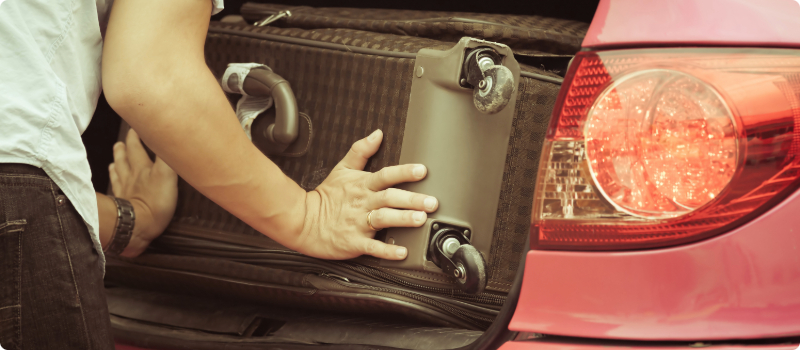Common insurance issues for Uber drivers
Updated June 17, 2024 . AmFam Team
Gaps in coverage can put rideshare drivers at risk. Learn how Uber rideshare insurance through American Family Insurance may help protect you and your car.*
At American Family Insurance, we support many small businesses, and that includes your rideshare entrepreneurial endeavor. That’s why we offer rideshare coverage that fills in a big gap left by the insurance Uber offers its drivers. So, when does Uber insurance cover you, and what are your limitations? Here’s the 411.

Does Uber provide insurance?
A rideshare company, like Uber or Lyft, typically protect you with liability coverage whether you’re waiting for a request, en route to pick up a passenger and when the passenger is in the vehicle. If you’re held liable for an accident, you’ll be grateful you have liability coverage, since it helps cover the costs for injuries you cause to a person or damage to their property.
Your liability coverage includes:
Property damage. This may help pay for damages that your vehicle causes to someone else’s property, whether it be their car, mailbox, home, etc. It’ll also help cover legal expenses if the other party files a lawsuit against you.
Bodily injury. This may help cover the expenses if you injure another person while using your car. It also helps cover legal expenses if another party files a lawsuit against you.
But this liability coverage offered by your rideshare company is limited and probably won’t fully cover you. And the liability limitations mostly exist in how you and your vehicle are protected. Keep reading to find out more about the gaps in your Uber insurance.

Personal and Uber insurance gaps
So, Uber helps cover you for liability (again, this is pretty limited liability coverage), but what else do they cover you for — and what don’t they cover you for?
Let’s break it down:
Stage 0: you’re off the clock and not logged into the app
You’re covered by your personal auto policy — not your rideshare company.
Stage 1: you’re logged in, driving around and waiting for a request
Once you’re logged in, you’re officially on the clock and using your vehicle for business purposes. That means that if you get into an accident and file a claim with your personal insurance company, you most likely will be denied. However, every insurance company will handle your claim differently.
Does Uber insurance cover your car during Stage 1? Stage one is considered a gap since you’re left with no coverage or very minimal coverage during this time. So, if you’re driving around waiting for a match, meaning there is no passenger in your car and you’re not on your way to pick one up, you may not be covered by your personal insurance policy during this time, and Uber’s insurance doesn’t cover your car for collision or comprehensive during this stage. Also, as noted before, your liability coverage limits are typically low here.
However, rideshare insurance with American Family Insurance steps in where Uber’s insurance leaves off.
To reiterate, if you get into an at-fault accident during stage one, you’ll usually be covered under your Uber’s insurance — but only for any damages you cause to another person or their vehicle. You personally will be minimally covered for any injuries, and damages to your vehicle almost always won’t be covered by your rideshare company at all.
Stage 2: you’ve made a match, and you’re en route
If you’re on your way to pick up a rider, Uber does insure you during this stage, but make sure you know exactly how you’re covered by them before you head out.
Stage 3: you’ve picked up your rider and are headed to their destination
Are Uber drivers insured to carry passengers? If you have a rider in your vehicle, you’ll typically have the same coverage that you do when you are headed to pick them up — and the rider in the car is usually covered as well. Again, be smart about your protection and check with your specific rideshare company to know exactly how you’re covered.
Here’s the gist:
- Sure, Uber offers insurance, but the coverage may not be enough.
- Your insurance Uber best covers you while you’re logged into the app and matched with a rider — i.e., when you’re on your way to pick them up and when they’re in your car.
- The gap in your coverage exists when your app is on and you’re waiting for a match. This period leaves you vulnerable.
This gap can easily be fixed with American Family Insurance rideshare coverage, which protects you from the moment your ridesharing app is on until you get matched with a passenger. You’ll get the same coverages that you have with your personal auto policy, including bodily injury liability, property damage liability, collision and comprehensive, medical expense and personal injury protection. And most of the time, the deductible you have with a rideshare coverage will be lower than that of your rideshare company’s deductible.

State-by-state insurance requirements for Uber drivers
Just like each state requires different minimums for personal auto insurance coverages, they also have different state insurance requirements for Transportation Networking Companies (TNC), such as Uber or Lyft. You’ll want to make sure that you understand the local or state regulations that are in place for TNCs and their drivers.
Limited benefits and discounts of your Uber company’s insurance
If you’re on the clock and only covered by Uber, you won’t be able to take advantage of the benefits and discounts that an auto insurance company offers.
With rideshare insurance from American Family Insurance, you may access roadside assistance, discounts for safe drivers, bundled house and commercial auto insurance, etc.
During the gap in stage one, our rideshare insurance may help you save money and stay protected on the road.*
How to protect yourself with Uber rideshare insurance
Review your policy with your American Family Insurance agent to learn more about your rideshare company's coverage gaps and find out if our rideshare insurance is the right coverage for you.
This information represents only a brief description of coverages, is not part of your policy, and is not a promise or guarantee of coverage. If there is any conflict between this information and your policy, the provisions of the policy will prevail. Insurance policy terms and conditions may apply. Exclusions may apply to policies, endorsements, or riders. Coverage may vary by state and may be subject to change. Some products are not available in every state. Please read your policy and contact your agent for assistance.
*Rideshare companies typically provides (refer to your rideshare company for their coverage details, limits & exclusions) limited liability coverage only, and no comprehensive/collision coverage for damage to your car during Stage 1. Coverage features and limits vary by state and may be subject to changes. Please check with your agent and read the policy for exact details on coverages and exclusions.

